Impartial training and careers advice
Call us: +441983 280 641
+441983 280 641
- How to become a Yachtie
So you’re thinking about becoming a Yachtie?
You may have a friend or relative who already works in the industry, or you have watched TV programmes like Below Deck , you know working on a yacht is the right for you, but where do you start?
With the potential to earn great money, travel, and work with loads of like-minded people, it’s not surprising this job ticks a lot of boxes for many people.
Becoming a Yachtie and getting paid to work on luxury yachts may seem like a job and industry that only the elite can have access to, or it just seems too confusing to start.
However, with an understanding of the requirements, certification, and having some expectations of what job role you should be looking for, starting work as a Yachtie will not seem so daunting.

What is a Yachtie?
Before we go any further, let’s make sure we are all singing off the same hymn sheet.
A Yachtie is a broad term used to describe anyone who works on a yacht. More specifically, it has become the term for people working as yacht crew on superyachts.
A superyacht is a very large boat that is extremely luxurious and often owned by multi millionaires and billionaires.
These Yachties who work on superyachts hold a number of different positions. Most Yachties will start their superyacht career working as a Deckhand or Stewardess. With more experience and responsibilities, your role will change as you progress up the career ladder.
It’s worth noting there are other types of yachting and Yachties. The other kind of ‘Yachtie’ could describe those who hold their Yachtmaster qualification and have jobs like skipper charter boats.
Job roles for new Yachties
Yachties new to the industry (also known as ‘Green’ Yachties) will traditionally apply for entry levels roles, which are Yacht Deckhands or Yacht Stewardesses.
These are both very different jobs, so you need to be sure which one you want to do and start training for that career path.
Yacht Stewardess (Stew)
A Stewardess, or Steward , looks after the interior of the yacht. This means anything that happens inside the boat, you will be responsible for it.
Think of any job in the hospitality industry and then combine it into one role on a yacht, that is what you will be doing.
From making beds, doing the laundry, cleaning, serving food, and hosting dinner, you will do it all to a 5-star standard. Anything less than perfect, and your guests won’t be satisfied.
It’s the small things that make the difference between high standards and exceptional standards. You must have a great eye for detail and be able to make sure no stone is left unturned. Everything on board the ship must be 100% perfect at all times.
You will be reporting to Chief Stew, who will be your manager and give you your task list. After a good few seasons as a green Stewardess, you will have enough experience and confidence to apply for Chief Stewardess roles.
Yacht Deckhand
In contrast to the Stewardess role, Deckhands look after the exterior of the boat.
Predominantly a male role, Deckhands will do everything from general maintenance to cleaning the teak deck, looking after the toys (Jet Skis, etc.), and even driving the tenders.
Deckhands should know how a yacht operates, the basic terminology used onboard, how to tie knots, and loads and loads of enthusiasm.
Deckhands may also dip in and out of helping the Stewardesses, and it isn’t uncommon for Deckhands to give a hand during busy evening meal preparation and service.
5 steps to Becoming a Yachtie
With an understanding of the job roles available, you can now decide which one best suits you. With the right attitude, qualifications, and knowing where to look for work, becoming a Yachtie is achievable for anyone who wants it.
- Have the right attitude
- Pass an ENG1 medical
- Complete STCW Basic Safety Training
- Gain experience
- Go to a superyacht marina
1. Have the right attitude
Along with gaining the correct qualifications to prove your competence, to become a Yachtie, you must have certain characteristics to thrive in this industry.
Yachties have to be well presented, articulate, know how to take orders, and be able to work hard, all with a smile and enthusiasm. You have to be able to work incredibly long hours, sometimes under stressful conditions, without losing your patience.
Having a job on a superyacht may sound glamorous, but if it’s your 10th day working in a row and you’ve got your head stuck down a toilet trying to clean it, you may want to think again. To become a Yachtie, you have to be happy with spending a lot of time away from home without seeing your friends and family. This may all seem obvious, but this situation does not suit everyone, and without careful consideration of the negatives, you will leave this industry quicker than when you arrived.
2. Pass ENG1 Medical
The first actionable step you need to take to become a Yachtie is gaining an ENG1 medical certificate. The ENG1 medical is an examination by an approved MCA (Maritime and Coastguard Agency) Doctor to make sure you are fit and able to work at sea.
Every single person working at sea must have an ENG1 medical certificate , without this, you are not able to start working on superyachts. The examination will take around 45 minutes, during which the doctor will go through a checklist to make sure you have no underlying health conditions that may impact the safety of you or anyone else on board the ship.
The most common reason new yachties fail the ENG1 is colour blindness. Surprisingly many people can go through their whole life without knowing they are colour blind. However, on board a ship, this can have huge implications. If you cannot identify signals and lights correctly, it will be impossible for you to help navigate the ship in an emergency. Unfortunately, this means you cannot start work as a Yachtie.
3. Complete STCW Basic Safety Training
Another requirement for working at sea is completing STCW Basic Safety Training . Similar to the ENG1 you can only get a job on a yacht if you have the STCW certificate.
STCW stands for ‘Standards of Training, Certification and Watchkeeping’. It is to make sure that all Seafarers have an understanding of what to do in an emergency and are aware of the procedures required.
STCW Courses are action-packed and quite a bit of fun. From fire fighting to sea survival, you will get stuck in learning, and learn loads of new skills.
4. Gain experience
If you are lucky enough to have a job offer on a superyacht, then having your ENG1 and STCW certificates will be enough.
Don’t worry if you haven’t already got a job offer, it’s quite normal to go through all these steps and not have a job lined up yet. If this is the case, gaining more experience and qualifications is a good idea to give you a competitive advantage over anyone else applying for the same job role.
This is achieved through signing up to a Deckhand or Stewardess Course. On these courses, you will get your standard STCW certificate and a list of extra qualifications demonstrating your competence, ability, and commitment to the industry.
Deckhands will learn how to drive a small yacht, engine maintenance, general yacht repair, and how to clean teak properly. Stewardesses will understand wine and how to serve it, the art of flower arranging, and how to drive a powerboat.
5. Go to a superyacht marina
After you have completed your superyacht training, now is the time to head out to France and look for work. Along with signing up to yacht crew recruitment agencies, going to one of the main superyacht marinas and handing out your CV to Captains is a great way to find work. This is known as dockwalking.
If you complete your Superyacht Course with us, you will have the option of signing up to our recruitment day in Antibes, France. We head out to France as a group, talk you through the process and offer you our industry contacts.
This is a great way to start your journey, and all our students find work in no time.
How much do Yachties make?
So you’ve heard you can make a good amount of money working on superyachts? Along with the travel, the great salary is why many people decide to become a Yachtie.
Like a job within any industry, salary varies. A Superyacht will agree on a crew salary budget with the owner of the yacht.
If you are just starting out, you can expect a salary of around €2,200 – €3,200 per month. However, the industry standard is €2,500 per month. Once you gain more experience and qualifications, your salary will increase.
When you look at the salary at face value, it looks great but not incredible, however when you are at sea, you have zero outgoings. Working on a yacht means you don’t have to pay rent, bills, or buy food which will save you heaps of money compared with working at home.
If you want to see the salaries of all yacht crew, check out our Salary Guide.
Do Yachties pay taxes?
Another reason why the salary is so appealing is that in most cases Yachties don’t have to pay tax.
This is a government scheme called the Seafarers Earning Deduction , and providing you are eligible, Yachties can keep 100% of their earnings.
To be able to apply for Seafarers Earning Deduction, you must be working on a ship outside of UK waters for a period of 365 days. This doesn’t mean you have to spend a whole year at once away from home, rather you can only apply once all the days you work on a yacht adds up to 365.
Being able to understand this tax scheme will be hugely beneficial before you start working on a Superyacht.
Download our free Guide
Want to know more about working on a Superyacht, please download our free guide .
Related articles
- Seafarers Tax
5 ways to ensure your SED claim is rock solid
The Seafarers’ Earnings Deduction, often referred to as the SED, is a tax legislation that enables seafarers to claim back their UK income tax. It a...
Do I need to pay off my Student loan if I work on a Superyacht?
Good question! First, let me say that the information below is aimed at people who have studied in the UK and took out a Student Loan to cover course ...
Have I got the right experience to work in yachting?
If you’re thinking about working on board a Superyacht, we share the skills and experience you need and how to get into the yachting industry in thi...
The ultimate guide to becoming superyacht crew

There are a plethora of reasons why more and more people are packing their bags and opting for a career at sea aboard a luxury yacht. After all, few jobs exist where you can be offered expense-free living, (often) tax-free salaries and desirable voyages around the world to exotic locations.
Factor in the meeting of interesting people, the opportunity to enjoy unique experiences and the memories you'll create, the prospect of working as superyacht crew is incredibly appealing.

A career at sea is a fantastic way to sample a unique lifestyle for a few years whilst saving plenty of cash for later life. But, of course, there aren’t quite enough superyachts out there yet for everyone to land that coveted crew job. So, how do you give yourself the best possible chance of standing out and securing a role on board?
Here we cover the essential steps and need-to-know information to give you the best possible chance of becoming superyacht crew.
Make sure you can work on a superyacht
It might sound slightly condescending, but, as with many other unique industries, not everyone is quite cut out for this line of work. As luxurious as it can be made to sound, there's a lot of hard, stressful, physically and mentally demanding work to be done as a crew member.
You’re often dealing with very wealthy, powerful owners and UHNWIs (ultra-high-net-worth-individuals) and their families, as well as serving their likely rich-and-powerful guests. Needless to say, they can be very expectant.
The hours – particularly when guests are on board – are typically very long. When you do get the chance to rest, you’re sleeping in shared cabins, away from home for extended periods of time, and personal privacy becomes a rarity. You have to be able to handle this whilst maintaining the high spirits and optimum levels of service.
Then, there are the formalities: Have you got the correct visas? Correct training? Any tattoos? Are you a smoker? These are all important factors that could impact your chances of securing a position on board.
In could you work on a superyacht? we list eight questions to ask yourself before deciding whether a superyacht career is for you.

Understand the different roles aboard and how you would fit in to them
The term ‘yacht crew’ refers to at least a dozen-or-so different roles on a superyacht. Some are more hospitality-focused, such as a steward or stewardess, while others are more skill-based, such as an engineer.
Whilst you may be planning to enter the industry as a deckhand or junior stew and work your way up, it’s important to understand the roles, duties, and responsibilities of all crew on board. Check out our guide on yacht crew positions and contracts for a complete rundown of what each role entails, as well as the average salary and main responsibilities.
Get trained up!
The marine industry is awash with crew training providers and a range of courses and certifications – some of which are mandatory, such as the ENG1 and STCW , while others will simply help you obtain a more desirable skillset. Find out which training you will need to undertake in our article, The right crew training for the right crew member .
Remember, having additional skills, languages and a busy personal life listed on your CV is a huge help in making you stand out from the sea of other applicants. So, consider which, if any, additional courses may help you in obtaining and succeeding in your chosen role before you actively start looking for work.
Get yourself out there!
Getting the mandatory crew training is a great start in your yacht job search, but is your crew CV as good as it could be? Are you looking for work at the right time and in the right place? Are you sufficiently prepared for your interviews? How does a superyacht crew job interview even play out? It’s important to consider all these things before hitting the dock.

It's logical to start with your crew CV. As with many things in the superyacht industry, there are some key differences between a CV in the corporate world and the marine/superyacht world, so we’ve written our own guide tailored towards writing a CV for work in the superyacht industry .
To find a position on board, it's recommended to move to the yachting hubs and hiring ports of the world, and networking in the local yachtie hangouts to get yourself noticed. The South of France and the Balearics are popular options.
Different yachting hotspots have their peak periods, as we discuss in depth in our How to choose the right hiring port article. Only experienced senior crew are likely to ever be flown out for interviews; so unless that's your forte, you’ll need to make sure you're on the ground in your chosen port, and as accessible as possible to potential interviewers.
Your yachting career will likely begin with daywork: Single, one-off jobs for a bit of cash and a nugget of valuable experience. If you do a good job, you might even get called back for further work. That's how it can all begin!
It’s time to nail the interview!
Job interviews aren’t the most enjoyable of experiences, regardless of the industry you’re entering. It's daunting and obviously rejection is never pleasant.
But, when you’ve gone to the effort of relocating yourself to search for crew work, and you’ve paid good money for multiple training courses and medical certifications, falling at the last hurdle hits even harder.
As a first-time yachtie, expecting a job offer for every interview you attend is unrealistic, but with some simple guidelines and advice, you can ensure you’re as well prepared as you possibly can be.
Much like crew CVs, job interviews can be a little different in the superyacht industry too. We go more in-depth on this topic in our How to succeed in a yacht job interview article, where you’ll learn what’s typically expected of yacht crew candidates at interview, amongst essential tips for the big day.
There are easier jobs to find in the world than a superyacht crew role – we all know that – but the amazing stories and experiences we hear from past and present crew are a testament to how those who put the hard work in really do reap the rewards. It can take time, but crew recruitment is worth it.
You can take a look at the crew agents listings here on Yachtingpages.com for agencies that can greatly assist in your search for a career in yachting. Alternatively, you can browse crew training companies for courses you'll need to get into the industry.
We wish all prospective crew the very best of luck in their job search!
Read other crew-related articles and guides in our specialist Crew Training and Crew Corner content libraries.
Tried & Tested

A jacket completes any crew member's uniform so it's an important garment to get right. In this Tried & Tested, Sea Design pits eight popular jackets against one another to determine which one is best for superyacht crew in 2023.
iAQUA creates high-performance, technologically advanced underwater scooters. In this Tried & Tested, a team of experienced testers have rated and reviewed the AquaDart Pro and AquaDart Nano series to reveal the stand-out iAQUA sea scooter.
In our 2022 Tried & Tested, yacht toy specialist EAMS and a group of captains and crew review a selection of the very best luxury water toys on the market. Find out which toy was crowned the winner...
iAqua has created a new sea scooter that is more powerful than a Porsche Carrera T, promising the ultimate marine advent...

SeaYou will be returning to Marina Genova for its 4th edition on Thursday 18th April and Friday 19th April, 2024....

Popular Articles
Finished reading now find your perfect supplier..
Search our industry-leading directory for over 20,000 superyacht suppliers, providers and marinas.

How To Become A Yacht Stewardess & Have A Career Of Fun

Over the years I have worked in many jobs to keep my travels funded. But by far the best job has been when I worked as a stewardess on yachts. For the avid traveller, there is no better job. If you are sick of working a 9-5, you want to get paid (well) to travel the world and are ready to make incredible friendships, then read on to find out how to become a yacht stewardess .
While there are numerous benefits to this job it can also be a lot of hard work. If you’re not completely sure what yachting is, this post will explain just that and give you 10 easy to follow steps to becoming a yacht stewardess.
This job will absolutely change your life and I’m excited to help you get started. I’ve been off yachts for a couple of years now and I miss it every day. I am still trying to devise a plan to get back on them sometime soon.

Disclaimer: Some links in this article are affiliate links, which means that if you purchase through them, I receive a small commission at no extra cost to you. For more information on my disclaimer click here .
- 1.1 MAIN RESPONSIBILITIES OF A STEWARDESS
- 1.2.1 HOW MUCH DOES A YACHT STEWARDESS MAKE
- 2 2. PACK UP YOUR BELONGINGS
- 3 3. QUIT YOUR JOB
- 4 4. ARRIVE AT A YACHTING HUB
- 5.1 WHAT DOES THE STCW 95 AND PDSD INVOLVE?
- 6 6. COMPLETE YOUR ENG1
- 7.1 HOW TO MAKE YOUR CV STAND OUT?
- 7.2 GET THAT CV OUT THERE
- 8 8. NAIL YOUR INTERVIEW
- 9 9. BECOME COMFORTABLE SHARING SMALL SPACES
- 10.1 HOW LONG DOES IT TAKE TO BECOME A YACHT STEWARDESS?
- 10.2 DO YOU WANT FURTHER STEP BY STEP INSTRUCTIONS TO BECOMING A SUPERYACHT STEWARDESS?
1. FIRSTLY, WHAT DOES A YACHT STEWARDESS DO?
“It’s like working on a cruise ship right?” I hear this time and time again – It’s nothing like working on a cruise ship. Cruise ships have 1000’s of crew and 1000’s of passengers. A superyacht although sometimes as big as a cruise ship only has a handful of guests and crew. Our job as a stewardess is to give impeccable, personalised service to our passengers.
Depending on the size of the yacht there are usually under 30 crew members. For example, a 50m yacht normally wouldn’t sleep more than 12 guests and only has 10-12 crew. It is essentially a floating 5-star hotel for the worlds richest people, celebrities and their guests. As a yacht stewardess, you need to predetermine everything the guests will require before you head out to sea and ensure they have the best time possible.

Because of the limited number of crew members, you’ll need to be filling multiple roles. When there are guests on board you could be working 14 hour days or longer. A yacht stewardess will be in charge of three main areas: housekeeping, service and laundry. You also need to look after the crew areas and set up and pack down for crew meals.
One thing I like to tell people about yachting is, “There is no job description”. You will need to be available 24 hours a day and ready for anything the guest requests. While this seems absolutely crazy the benefits make it all worthwhile. Read an interview with yacht stewardess Melissa Ryan on why she loves being a yachtie. When there are no guests on, regular working hours are 9-5 Monday to Friday with weekends off.
MAIN RESPONSIBILITIES OF A STEWARDESS
- Provide 5-star service ensuring complete satisfaction of guests
- Foresee any items, food and drinks they could want while out at sea
- Set up and provide bar service, knowledge of cocktails and wines
- Perform different styles of meal service depending on guests requirements. From silver service, synchronised to buffet and anything in between.
- Create daily table centrepieces
- Create and maintain floral arrangements
- Host cocktail parties and other events on board
- Provide housekeeping and laundry service for guests and crew
- Be available at all hours of the day and night
- Take turns at watchkeeping and staying on board
- Ensuring the supplies, wines and decor is properly inventoried
- Shopping for crew provisions including toiletries and staff mess foods.
THE BENEFITS OF BEING A YACHT STEWARDESS
Ok! Where do I start? There’s no more daily commute . Next time you’re stuck in peak hour traffic, think back to this. Roll out of bed after having arrived during the night to a new remote Caribbean island and be at work. Pretty great!
Next, you get to live with all of your friends . You’ll never get bored on a yacht, that’s for sure. When you knock off work for the day grab your buddies and head off exploring that new island. If you’re in the Mediterranean (Med) visit the ancient Greek ruins or pop into a French cafe for a croissant. Maybe you’re in the South Pacific. I hope you like water sports. There’s plenty of time for that.

Working on a yacht will look great on your CV . You learn invaluable new skills and gain life experience while you’re at it.
You make great money . Yep, you read that right. Not only do you get to enjoy these amazing benefits, but you also get paid well to do it. Depending on where you are from this could even be tax-free. Most starting wages are upwards of 2500€/month plus in some cases tips.
It’s exciting! You never know where you’ll be next month, you’re always meeting new people, you get days off in some of the world’s most incredible locations and you will witness the most unreal sunrises and sunsets.
HOW MUCH DOES A YACHT STEWARDESS MAKE
Check out this table to see the current yacht stewardess salary. All wages are per month in Euros. These are the ranges taken from the Annual Dockwalk Survey of 2019.

2. PACK UP YOUR BELONGINGS
Have you decided being a yacht stewardess is for you? Congratulations, then this post is for you! The first step is packing up your belongings. You’re moving on to a boat, so pack as light as possible . Depending on where you go to get your first job (more on this in the next steps) you can pack accordingly.
in the Caribbean, it’s unlikely you’ll be needing heavy winter gear. A light jacket and pair of jeans will be sufficient. If you’re heading to the Med warmer clothes will be useful. Don’t take big bulky sports gear or you might be sharing a bed with them. If possible take a bag which can fold up as opposed to a hard suitcase. On some boats this is mandatory.
3. QUIT YOUR JOB
Yep, do it ! *Cheers* “Yacht stewardess life come at me”.
Stop guessing what you need to do to get a superyacht job and use this checklist to beat the compettion
4. ARRIVE AT A YACHTING HUB
Now for the fun part. Where do you go to get a job as a yacht stewardess? Being a new crew member you want to maximise your chances of finding a job. How do you that? Yachting has two main seasons – Summer and Winter. At the end of each season, there is usually a lot of crew turnaround. During that time captains and owners need to do mass hiring twice a year. The Northern Hemisphere summer season sees most boats go to the Mediterranean or the North East of the USA. The winter season is predominantly in the Caribbean.
As mentioned above if possible you will want to arrive into the yachting hub at these peak seasons. For the winter Caribbean season, you need to be in Fort Lauderdale , USA by October/November . For the summer Mediterranean season get to Antibes, France or Palma De Mallorca in April/May .

There are crew houses designed especially for people like you. People who want to become a yacht stewardess, a deckhand, a chef and people who already are but looking for their next job. These crew houses understand the volatility of the industry and that you may be there for one week or two months. Stay in a crew house to alleviate paying bonds and monthly contracts plus meet cool people and unofficially start networking (more on that later).
5. FIND A TRAINING SCHOOL TO DO YOUR COURSES
Now you can’t just jump on a boat. There are a couple of basic safety training courses required before you are legally allowed to work as a yacht stewardess at sea. The first course is Standards of Training and Certification of Watchkeeping known as the STCW 95 or STCW basic safety. You will also need to get your Proficiency in Designated Security Duties ( PDSD ). In the yachting hubs mentioned above, there are multiple training schools to choose from. One reputable company located in both Europe and the US is Bluewater Yachting .
While you can do these courses around the world (potentially at home). I recommend doing them where you intend to find work. Yachting is all about networking and being in a class with 20 other students instantly connects you with other like-minded individuals. Some I might add could even be a chief stewardess doing her refresher and potentially looking to hire. Hint hint…

WHAT DOES THE STCW 95 AND PDSD INVOLVE?
The STCW 95 is your basic minimum safety training required to work on a superyacht. There are four components which take five to six days to complete.
1. Fire Prevention and Fire Fighting (Basic Firefighting) 2. Personal Survival Techniques (PST) 3. Personal Safety and Social Responsibility (PSSR) 4. First Aid / CPR (Basic First Aid) 5. Proficiency in Security Awareness (PSA)
This entry-level course is open to anyone and costs around $900 USD or 1200€ to enrol. While this sounds expensive, you’ll be making your money back in no time. This course is a lot of fun. It’s very practical and the firefighting component gave me so much respect for our firefighters. It’s hot and hard work!

The PDSD course is for all seafarers who have designated duties under the ship’s security plan. In the superyacht industry, almost all crew members have designated duties – meaning you need to do this course too.
This one day course costs $300 USD or 280€. You will learn about different security threats to yachts both in dock and at sea, how to recognise them, the use of proper security equipment and how to maintain your ships security plan.
6. COMPLETE YOUR ENG1
The ENG1 is your ships medical certificate. This is irreplaceable with other medicals no matter how thorough they are. You need to have a document stating you passed your ENG1 to join the yachting industry. There are only a few doctors around the world who conduct this examination so it’s wise to book ahead. Places like Fort Lauderdale can have one month waiting periods during peak season.

7. WRITE A YACHT STEWARDESS CV
Writing a yacht stewardess CV is a lot different from writing a CV for a regular job. Captains receive hundreds of applicants during peak hiring periods. With many of these people having zero experience onboard a yacht, you need to know how to make yours stand out.

HOW TO MAKE YOUR CV STAND OUT?
Start off by adding some colour, not just a heading here and there. I mean big bold blocks of colour. Put in shapes of block colours and overlay with your text. Change up the format.
Oh, another resume that looks the same… boring. Next. Oh wow! Whats this column on the left about? It’s describing the person and their skills. Hmmm, I’ll keep reading.
While maybe this isn’t exactly how a captain thinks it may as well be. Choose a colour scheme and make it look fun. Just make sure it’s still professional and you can read everything. Make sure you include a picture of yourself and a detailed about me section stating your availability and current location. Add some interests and hobbies, because remember you’re applying for a place in someone’s home as well as a job as a yacht stewardess.
Need help? – I offer personalised services to help you write your CV. Please get in touch for my rates.

GET THAT CV OUT THERE
Once you have a great CV outlining why you will be the best yacht stewardess you’ll need to get that CV out there. There are a few ways to do this. Firstly you can sign up for a crew agency . These agencies take on the new and old crew and work with the yacht captains and owners to find the most suitable person for the role. This is a free service. Never sign up to an agent who is charging a fee.
Another way to get your resume seen is through networking . Networking sounds daunting but really it’s just about being a nice, happy person and getting out socialising. Before the season starts basically everyone who has anything to do with yachts wants to throw a party to advertise their brand. In short as a wannabe yacht stewardess you get free entry into these lux parties, usually a bunch of free drinks to go with it and now you’re networking. Get out there talk to strangers and make connections. You never know who you’re talking to and if they need an additional crew member.
There are also numerous online job boards . You can submit your resume directly to some of these or read advertisements from people looking for a yacht stewardess.

8. NAIL YOUR INTERVIEW
As a result of your CV being out there, you’ll be getting all these calls asking for you to come in for an interview. They want you to be one of their yacht stewardess’s! To begin with, you need to dress the part . Make sure you’re hair is up and neat and you have light minimal makeup on. Wear a polo shirt with either a skirt, skort or shorts that is a respectable length in a navy, black or beige. Most interviews are conducted on the yacht in person, so I wore flip flops to all of mine. This is because once you reach the boat it is yacht etiquette to take your shoes off before boarding.
Tip – I know a lot of chief stews who look at nails, therefore make sure your nails are well manicured.
A usual interview will start with a tour of the yacht. The person interviewing you will then make sure you understand everything there is to know about the role, the schedule of the boat and about the current crew and their daily habits. While not all interviews are super laid back, as a new crew member, they know you do not have experience on boats. What they want to know is if you will be able to gel with the current crew. Will you be someone they can share a small amount of living space with. Will you be someone who can learn new skills and pick up this new lifestyle. Most importantly, be yourself, be happy and have fun.

9. BECOME COMFORTABLE SHARING SMALL SPACES
If you want to work as a yacht stewardess, you need to learn to share a cabin with someone. Your cabin is most likely a quarter of the size of your current bedroom if not less and add to that it’s shared. Welcome to crew living! This is why you need to pack light. All of your belongings will need to fit in a wardrobe much smaller than what you are used to.
Things to remember when sharing a small space whether it’s your cabin or the crew mess (living area). Be respectful of others belongings – if it doesn’t belong to you, don’t touch it. Clean up after yourself . There’s nothing worse than living with someone who is a grot. Be courteous . Your crewmates are working weird hours, don’t be the reason they can’t sleep.

10. ENJOY YOUR NEW LIFE AT SEA!
Finally and most importantly enjoy your new life at sea ! Being a yacht stewardess is such a special career and there is nothing which compares to it. Savour the unique experiences which will present, see the world while getting paid, make lifelong friends , learn new skills and enjoy being rocked to sleep by the rolling waves.

HOW LONG DOES IT TAKE TO BECOME A YACHT STEWARDESS?
Actually not long. The required courses and ENG1 can be done in a week. The longest part is the preparation of packing, heading to a yachting hub and then searching for a job. Most people I know found a job within a couple of weeks to 2 months. However, this will vary depending on the time of year you seek work.
DO YOU WANT FURTHER STEP BY STEP INSTRUCTIONS TO BECOMING A SUPERYACHT STEWARDESS?
Does this sound like something you would like to do ? If yes, then let me introduce you to my book Superyacht Crew. Over the past four years, Melissa Ryan and I have worked onboard yachts in various positions. While you can absolutely follow the steps listed above, but if you would like more detailed help entering the industry than this is the book for you . Each year more people make the switch to working aboard superyachts. If you are serious about making this career yours then act now.
Superyacht Crew: How to Start Your Career in the Superyacht Industry is full of information and secrets we learned from our combined years of yachting. This comprehensive guide has helped numerous friends and family members make this dream a reality. Now we want to help you ! Get step by step instructions no matter where you are in your job search. Gain insider knowledge, use our yacht stewardess CV examples and find learn to ask the right questions in your interviews.
My favourite part of the book is the detailed reference guide . We know the best crew houses, crew agencies and training schools. We either used them personally or have friends who did. Don’t waste time finding misleading information online, use our tried and tested companies to start your career. Do you want to know which doctors do the ENG1? We have listed where you can find qualified ENG 1 doctors around the world.
Make sure you join our facebook group for new yachties and ask us any questions you have.
Click to buy superyacht crew: How to start your career in the superyacht industry today
My name is Erin, the lady behind Curiously Erin. After more than 10 years of travelling and working abroad, I wanted to create a platform where I could share my stories and travels. My goal is to help you live the life you desire and inspire you to travel more.
Similar Posts

Yacht Jobs: 10 Reasons Life As A Yachtie Will Be Your Obsession
Every year, we make resolutions to change something about how we’re living our lives. If you want a career change that allows you to travel…

How To Become A Flight Attendant With No Experience In The Uae
Could you ever imagine waking up in Abu Dhabi, having breakfast in Paris, lunch in Cyprus, and dinner in Singapore? That’s the life of a…

30 Best Digital Nomad Jobs – How To Work And Travel
Imagine never having to put in for holidays at work again. Instead, packing up and going where your heart desires. Working in cafes in Paris,…

Everything You Need To Know About Ski Resort Jobs Australia
Have you ever thought about working a snow season? Maybe you’re a keen skier or snowboarder and want to take your riding ability to the…

What Are The 21 Best Gifts For Bloggers This Year?
Giving gifts to a blogger is SO difficult. Like, what do they even do? Most of my family and friends don’t understand this line of…

5 Great Reputable Companies To Teach English Online With
I’ve done a lot of research on finding the best companies to teach English online with. Once completing my online TEFL certificate (Teaching English as a Foreign Language) it…
How to become part of the yacht crew?
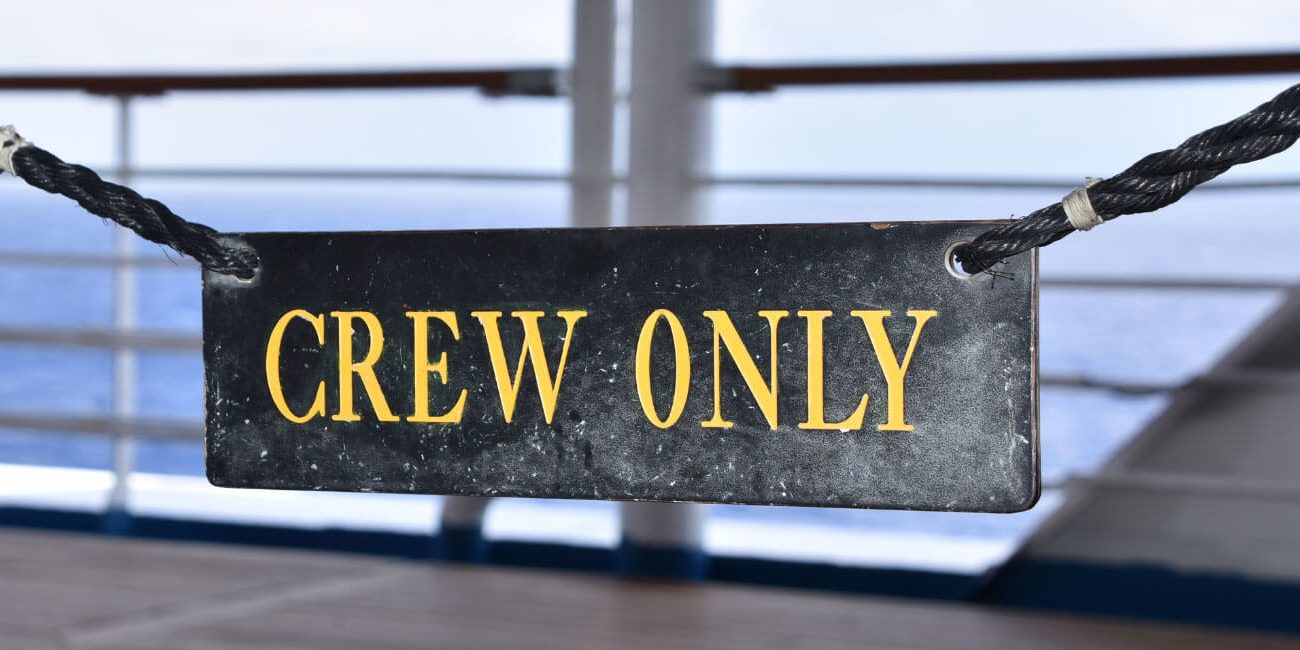
Have you ever wondered how to start a career on the luxury pleasure vessels? Well, yes, everyone’s goal is to step on a 80-100m yacht one day and become a part of her crew. There are over 10,000 yachts over 24 meters in the world and they are mostly moored in the Mediterranean and US coast. Yachting industry has approximately 150,000 to 170,000 crew members worldwide. What is it that makes you unique to stand out in yachting? Experience is the most important thing for boarding a yacht, but how to do it if you don’t have it yet? How to start building it? We are the answer to your problems!
Let’s start! For excellent profiling in the yachting industry your characteristics, communication skills, cheerful approach, organization and stress management are very important. But to apply for a job on a yacht the first things you need to have are STCW certificates, ENG 1 and Seaman’s book. The good thing is that you can do all those in AYA. Basic safety is a basic STCW certificate that every crew member must have. The course lasts 6 days and after passing the exam you get a certificate recognized from the EU, valid everywhere in the world. ENG 1 is a term for a medical certificate which proves that you are capable to work on a yacht as a crew member. Seaman’s book is a document issued by the Harbor Master’s Office in which your work on board is recorded.
Knowledge and experience are not the only essentials to enter this world easily! Certificates are the ones that catch the attention of the crew agent, the ship owner and the captain who hire you because the certificate is a confirmation that you are ready to work on your knowledge and progress day by day. Atlantis Yachting Academy created its courses according to the highest industry standards and adapted them to market requirements which is why we are recognized in the world of yachting.
Our courses will surely teach you and prepare you to enter this harsh industry that does not forgive mistakes, but will also position you very high on the evaluation list. Before each embarkation, you must understand the positions, requirements for those positions and what is expected of you as a crew member in that position, as well as report accordingly. It is not recommended to apply for all positions because you show an urgent need to board which is not a good sign.
Your training and qualifications are the most important elements to stand out, the more additional courses and the more knowledge and skills you have, the more attractive you are . Check AYA’s additional course list and find something that interests you and that will separate you from the rest. Your CV is your mirror , the first impression is decisive and the first thing a crew agent or captain gets is your CV. Fortunately, after completing one of AYA’s main courses you will be able to create a professional CV under guidance, so your CV can overshadow everyone else’s.
Create a list of crew agencies, captains and yacht owners. When you sign up for the first time, it’s better to do it in person instead of via e-mail because that way you create a better image of yourself and, psychologically speaking, it’s more difficult to turn you down. If you are unable to do so, send e-mails and make phone calls. Determine the daily and weekly list of visits and calls and decide which places you will call and which visit. Check in with them once a week and consider this to be part of your job. That way, boarding is guaranteed. A big advantage for AYA members are our contacts, our extensive network of crew agencies, yacht owners and captains will help you greatly with your employment. So far, AYA has managed to board all of its participants and everyone is extremely satisfied with their work.
Related Posts

Yacht Crew Wanted
Amateur and professional yacht crewing positions available worldwide, from daysailing to transocean for all experience levels.
Search sailing opportunities
For yacht crew
It’s free for everyone to browse though all of our current sailing opportunities. Become a member to contact yacht owners and join their crew.
For yacht owners
Registration and posting is free if you are looking for a skipper or crew. Find amateur and professional crew for short or long term voyages.
Featured sailing opportunities

Crew wanted for Mediterranean and beyond
Boat type: Gulfstar 50 MK ll Ketch totally rebuilt 2015
Location: Italy, Spain, Morocco, France, UK

Americas Cup (AC37) Barcelona 2024
Boat type: Hanse 385
Location: Tivat Montenegro

PS40 MX to Papua New Guinea by early '24
Boat type: Cutter Rig Bluewater Passage Maker
Location: Puerto Vallarta, Mexico
Coastal yacht cruising
Professional sailing jobs, ocean sailing voyages, yacht delivery crew, worldwide opportunities, varied vessel types, all experience levels, mile building voyages, short notice sailing, environmental & wildlife vessels, we are recommended by.

Crewseekers notices

What makes an RYA Yachtmaster?
James Stevens, former Chief Examiner of the RYA tell us.
Skipper for Private Catamaran Charters in Malta
More information

Day Skipper & Yachtmaster theory courses - 20% off
Online RYA theory courses with a great discount courtesy of Crewseekers.
we love sailing as much as you do
Crewseekers is run by experienced, professional sailors offering a friendly and helpful service to yacht crew and owners. We are the original yacht crew introduction agency – established for over 25 years, offering amateur and professional sailing opportunities throughout the world.
Work On A Yacht
How to become a yacht stewardess: the a-to-z quick start guide.
THE QUICK START GUIDE: THE A TO Z OF HOW TO BECOME A YACHT STEWARD/ESS In the first half of my book, The Insiders' Guide to Becoming a Yacht … [More...]
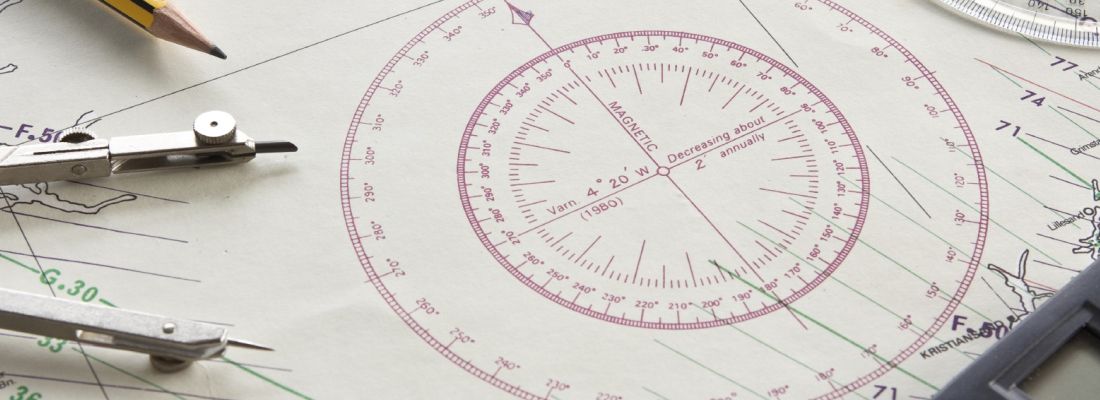
“The Insiders’ Guide to Becoming a Yacht Stewardess” 2nd Edition – Out Now!
Welcome to the World of the Rich and Famous... Travel, Adventure, and Multi-Million-Dollar Yachts A sea of opportunity awaits you in one of the … [More...]
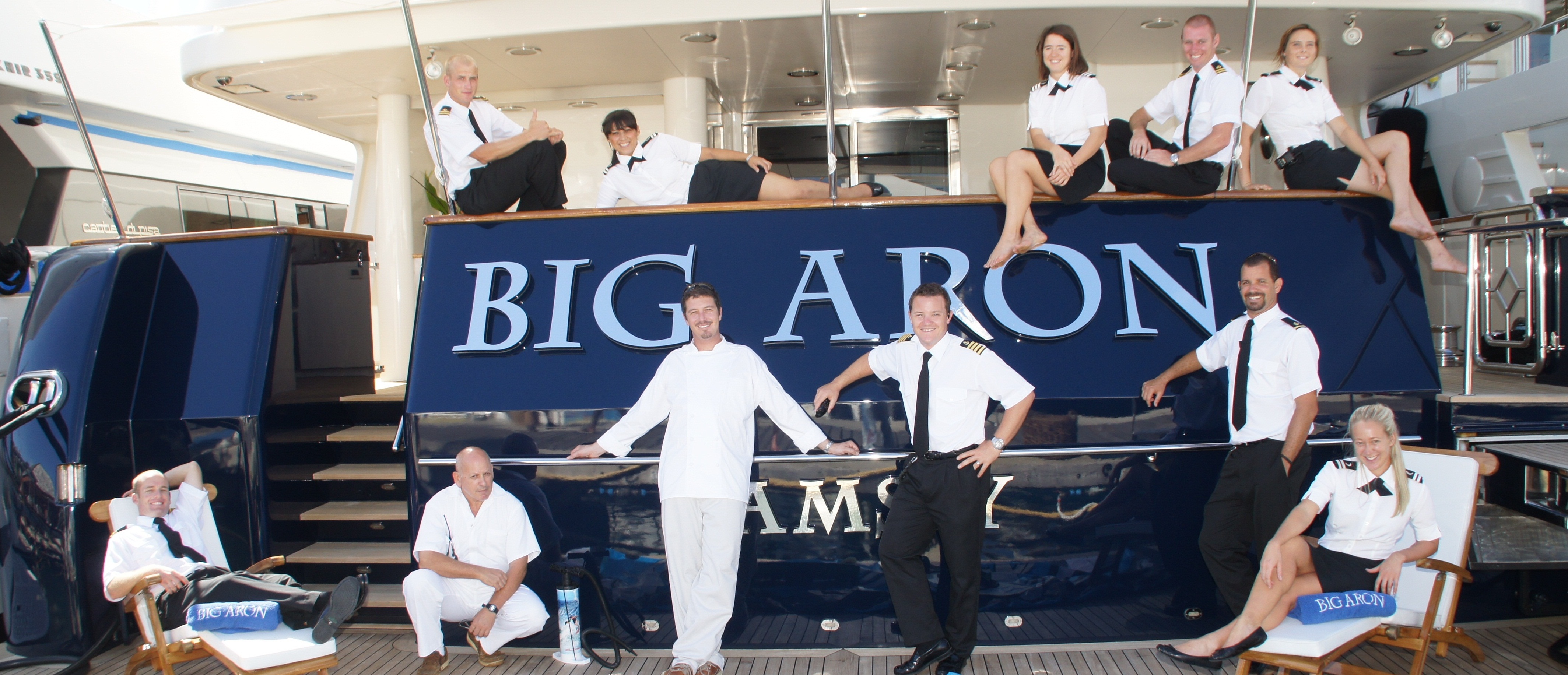
Yacht Stewardess – A Detailed Job Description (Book Excerpt)
"Julie from The Love Boat Ain't Got Nothin' on a Yacht Stew," an excerpt from Chapter 4: Around the World with a Silver Tray -- What Becoming a Yacht … [More...]
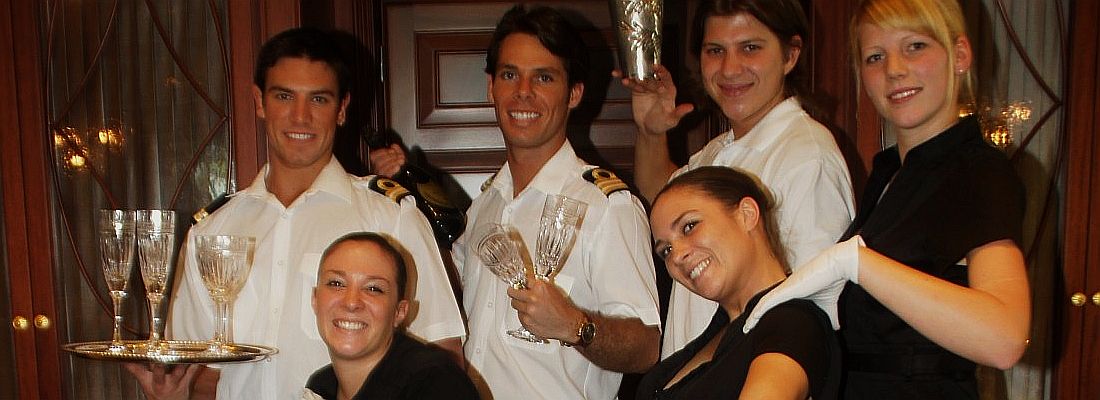
"The Insiders' Guide to Becoming A Yacht Stewardess" Subscribe Now
Read the Preface to “The Insiders’ Guide to Becoming a Yacht Stewardess”
February 20, 2023 By Julie Perry
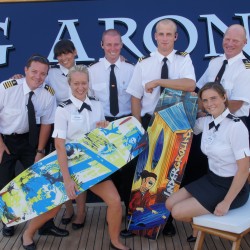
Following is the Preface to the 2nd edition of The Insiders' Guide to Becoming a Yacht Stewardess: Confessions from My Years Afloat with the Rich and Famous, published in 2006 and updated in 2013... [And if you're ready to begin your yachting … [More]
Superyacht Crew Jobs: Gain Skills for a Bright Future
December 30, 2022 By Julie Perry
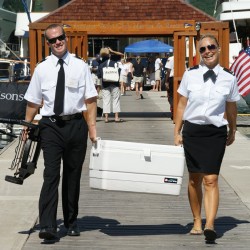
Superyacht Crew Jobs Available NOW Superyacht crew jobs abound right now! Due to the pandemic, there has been a major increase in demand for superyacht crew to fill all positions onboard. This is especially true of the need for American crew to fill … [More]
Working on Cruise Ships vs. Superyachts – A Vast Sea of Difference
October 5, 2022 By Julie Perry

Here's an excerpt from The Insiders' Guide to Becoming a Yacht Stewardess: Confessions from My Years Afloat with the Rich and Famous: I Must Confess… We yachties sort of frowned upon what life might be like aboard the ol’ cruise ships. We were … [More]
July 6, 2022 By Julie Perry

THE QUICK START GUIDE: THE A TO Z OF HOW TO BECOME A YACHT STEWARD/ESS In the first half of my book, The Insiders' Guide to Becoming a Yacht Stewardess, I discuss the yachting industry and give you insight into what this world is all about. I also … [More]
Careers in the Yachting Industry: What Can a Yacht Stewardess Do in the Future?
May 1, 2022 By Julie Perry
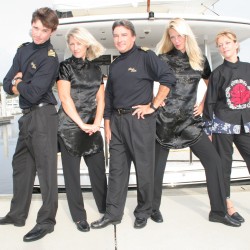
One of the chief questions I hear from people I recruit into the yacht-crew industry is this: "But what will I go do after that?" For some yacht stews, the job represents a long-term career path where they can work up to chief steward/ess status and … [More]
Tales from a Superyacht Stewardess: A Party Debacle on Oscar Night
February 7, 2022 By Julie Perry

A sample "Confession" from The Insiders' Guide to Becoming a Yacht Stewardess: Confessions from My Years Afloat with the Rich and Famous... Julie and her crew tried to go the extra mile by throwing an Oscar viewing party for their billionaire guests, … [More]
YachtieCareers
Free yacht course - become yacht crew.
The first step to your new Career | Create your Members profile in the Introduction course and get started.

What is included ?
Everything you need to start your Superyacht Career.
Superyacht Introduction Course
Members profile - so that we can create a personal plan for you
Phone call. 1-1 Free Consultation with our Superyacht Captains
Course curriculum
Welcome on board.
A message from your Instructors
How to Become Yacht Crew
1. Yachtie - The Introduction
Intro to Module
Your Yachting Industry
Joining the Industry
2. Yachtie - Junior Crew Positions
Intro to Positions
Choose your entry level position
Superyacht Positions
3. Yachtie - Select your Location
Intro to Locations
Where do you start working ?
Where is the best place to start ?
4. Yachtie - Crew Salaries and Packages
Intro to Select your Salary
4- Salaries and Packages (1)
Your salary package
5. Yachtie - Select your Superyacht
Intro to Select your Yacht type
Which Yacht do you want to be on ?
Your Superyacht type
6. Yachtiecareers - Start on Superyachts now
Your Personal Training programme - Start Online + STCW 7 Days
2. Set up your personal Yacht training
3. Let us get started
Book a Free Consultation
7. Become Stewardess - Your Plan - Start online + 7 Days STCW
100$ Free Credit - Payment Plans
Become a Stewardess - Your Plan
8. Become Deckhand- Your Plan - Start online + 7 Days STCW
Copy of 100$ Free Credit - Payment Plans
Become Deckhand - Payment Plan

About this course
- 0.5 hours of video content
Yacht Stewardess Training
Limited Time Special Offer
Yacht Deckhand Training

The Quick & Easy Guide to Superyacht Chef Careers

This article is the latest instalment in our series of guides on superyacht careers. We’ve already covered deck , interior and engineering careers, but today it’s time to get delicious and discuss the career pathways for chefs on board yachts.
As always, the information in this guide is brought to you by the experts at the careers guidance platform, Academy by Ephemeris . Start or advance your yachting career with Academy by Ephemeris, the only online tool that connects superyacht crews and aspiring crew with yachting industry training providers worldwide.
What does a superyacht chef do?
A superyacht chef is in some ways, the central character in a guest or owner’s experience on board. They are the unsung heroes that use the culinary arts to turn yacht voyages into unforgettable memories, and it’s all done from the galley - the marine industry term for the onboard kitchen.
The chef’s primary responsibility is planning, preparing and cooking food for the guests/owner, the captain and the crew. But there’s a lot more to the chef’s job, too.
The chef’s daily responsibilities include regularly provisioning all required food items, which also entails frequent food inventory records to ensure that any food items required for a particular trip or charter booking, are ordered and delivered on time. They are also responsible for checking that all received food items meet the yacht’s standards, following which all items must be safely and correctly stored according to all required food safety and storage standards.
Galley safety and sanitary standards are also the chef’s responsibility, and if other galley staff are on board - as they may be on larger yachts - the chef is responsible for managing those staff, too.

How do I become a superyacht chef, what qualifications do I need?
Generally, you would begin by obtaining formal food preparation training, such as an NVQ (National Vocational Qualification) Diploma from the City & Guilds framework.
Next, you will need a minimum of a Level 2 Food Hygiene Certificate. This internationally accredited certificate is a mandatory requirement for all food handlers and servers. It teaches the basic knowledge of how to safely store, handle, cook and serve food onboard a superyacht in a hygienic and safe manner.
For chefs working on commercially registered yachts (charter yachts) and/or chefs cooking for 10 or more crew, a further requirement - the Ship's Cook Certificate – was introduced as part of the Maritime Labour Convention (MLC, 2006) in 2014.
Rather than being a course to teach superyacht standard food for guests, the Ship's Cook Certificate was created with the purpose of ensuring that cooks working on commercial vessels have the basic skills and knowledge to cook for the crew on board.
“The Ship's Cook Assessment for the Certificate is designed to ensure a basic minimum standard – it is not designed to catch people out. If you know how to cook and you operate using best practice, there is no reason why you will not pass the assessment,” explained Chef Duncan Biggs, MD of OceanWave Monaco.
In order to attain a Ship’s Cook Certificate, you will need the following:
- Proof of at least one month’s sea time, at sea or alongside.
- Proof of at least one year as a chef or as a cook in a professional working environment.
- Certificate of successful completion of the Assessment in Marine Cookery.
- Class-based Food Safety Level 2 (MCA - Maritime and Coastguard Agency) or Level 3 (Cayman Islands).
A formal competency check via the Ship's Cook Certificate of Competency is mandatory, even if you hold an SVQ (Scottish Vocational Qualifications) or NVQ Level 4 to UK standards.
All crew, including chefs, need an STCW (Standards of Training, Certification and Watchkeeping for seafarers) certificate in order to work on a yacht. This is a five day course that covers general safety at sea. You will also need to obtain an ENG1 medical certificate from a certified medical practitioner.

Is it better to start off working onshore?
The majority of yacht chefs train and develop their skills onshore first before pursuing a cheffing career at sea. Chefs who have had extensive training and career experience on shore, particularly if they have worked in fine dining or Michelin-starred restaurants, are highly sought-after on yachts.
Is cheffing at sea any different to cheffing ashore?
Yes, it’s very different!
A head yacht chef is responsible for meal planning, menu development, food provisioning and preparation, cooking and galley cleanliness. On smaller yachts, chefs often work alone, further adding to their workload.
Additionally, superyacht chefs - especially those on board charter vessels - need to have the ability to perfectly cook a wide range of cuisines and accommodate a wide range of dietary preferences, including gluten free, vegetarian, and vegan options, all prepared to a very high standard. Guests accustomed to dining in the world’s best restaurants expect a similar level of culinary perfection on board.
There are logistical differences, too.
If a chef onshore needs an ingredient at the last minute, it can often be sourced relatively quickly and easily - sometimes even from a nearby store. At sea, however, a chef must be prepared to be much more resourceful given that it’s more challenging to source provisions, particularly at short notice, so a missing or spoiled ingredient can otherwise quickly become a disaster. Though larger yachts typically have more galley staff, it is generally still not to the extent of kitchens ashore and even then, yacht chefs must simply be more resourceful while being prepared to be busy for longer hours every day.

What are the different roles within the yacht chef pathway?
Yachting’s culinary world offers several distinct roles.
Junior Chef: This role offers newly trained chefs a chance to familiarise themselves with the nuances of yacht kitchen operations while learning vital occupational skills from more experienced professional chefs. By assisting seasoned chefs, junior chefs lay the groundwork for their journey ahead.
Sous Chef: Positioned as the second-in-command to the head chef, the sous chef becomes the cornerstone of the galley, often stepping in to lead the culinary charge.
Specialty Chefs: For those with a unique culinary passion, such as pastries or sushi, specialised roles - when available - provide a platform for niche creativity.
Head Chef: At the apex of the galley staff hierarchy, the head chef orchestrates the galley's operations, ensuring every dietary requirement and preference is exquisitely catered to.
Conclusion
Climbing the ranks in the superyacht chef’s culinary world necessitates a commitment to continuous learning. Of course, exploration of diverse global cuisines and networking within the superyacht community can propel your career substantially, but getting started requires having the right training. That’s where Academy by Ephemeris comes in.
Using the Academy by Ephemeris platform, you can access the training you need to begin, develop or advance your chef yachting career - or any career on yachts - wherever you are in the world. Academy by Ephemeris is designed to connect you with the right courses from carefully vetted training providers worldwide, whenever you need them.
Finally, a big thank you to Chef Duncan Biggs at OceanWave Monaco for his assistance with this article.

Post your comment
You cannot post comments until you have logged in.
No one has commented on this page yet.
RSS feed for comments on this page | RSS feed for all comments
Search articles with keywords

- Charter & Brokerage
- Yacht Design & New Builds
- Tenders & Toys
- Superyacht Events Calendar
- Career & Training
- Departments
- Superyacht Crew Finances
- Sustainability
- Shipyards and Marinas
- Health & Wellbeing
- Polar Region
- Our Services
- Meet the Team
How to Become A Yacht Engineer
.png)
Are you looking for a career as a yacht engineer?
Wilsonhalligan have compiled a breakdown of the qualifications and requirements needed to start out as a yacht engineer. As well as insight into the job day-to-day and how to effectively land your dream position.
What does a Yacht Engineer do?
It depends on the type, size and usage of the yacht. But, the Engineering department are responsible for the operation, maintenance and repair of all:
- electricals
- electronics
- as well as in some cases, structural systems and appendages found on board a modern yacht and superyacht.
Skills needed to be a successful Yacht Engineer:
The role requires a keen eye for planning and organisation. Planned maintenance (carrying out preventative and explorative maintenance before failures occur) is a very important aspect in modern marine engineering. Skills in project management, resource allocation and time management are very desirable, in addition to extensive and diverse technical ability. Many yachts employ software programmers to aid a methodical approach to planned and preventative maintenance, as well as to record failures and repairs as they occur. As well as keeping an accurate inventory of spares held on board. Being able to efficiently use such software programs efficiently would be highly advantageous. Examples of these asset management programs are AMOS and IDEA .
Challenges as an Engineer Onboard a Yacht:
Engineering on a superyacht has particular challenges. Some yachts (particularly charter yachts) can be very busy, meaning a very fast paced and demanding environment. High expectations from owners and guests in regards to service and entertainment also puts a keen onus on engineering departments. They are expected to keep all systems working to minimise or eliminate down time and negative impacts on the itinerary. Of course, when the yacht is at sea, many of these systems are safety critical. Break downs and failures offshore bring a whole new set of challenges and risks.
Which qualifications do I need to get in to Superyacht engineering?
There are really two main entry routes in to yacht and superyacht engineering. They follow two distinct certification pathways – entering from commercial shipping, or working through yacht-based certification routes.
Firstly, the Commercial Shipping Route of Training for Yacht Engineering:
The Commercial Shipping route most commonly begins with a sponsored cadetship with a shipping company. Who, are working in partnership with maritime training providers. Candidates must apply to one of a number of cadetship schemes. And, if accepted will undertake usually 3 years of study and work experience on the sponsoring companies’ vessels. Culminating very often in the Officer of the Watch (Engineering) or ‘EOOW’ ticket. And, usually either an HND or BSc Degree in Marine Engineering or similar.
Once the EOOW certificate is in hand, candidates can be considered suitably qualified. As well as experienced for junior engineering officer roles on large yachts. A common first yachting job for EOOW qualified candidates is 3 rd Engineer. The main advantage of a cadetship is that seatime is gained quickly and on vessels over 3000 GT. It also allows for a ticket which is ‘unlimited’ by tonnage as all yacht engineering certificates are. This opens the door to working on the world’s largest mega and superyachts.
Also, the sponsoring company pays for all courses and examinations which would be extremely expensive if self-sponsored. And, very often a small training bursary is paid on top (some as much as €11,000 / year). The biggest disadvantage is that candidates will have to commit to different types of vessels during the cadetship. These are likely to be chemical tankers or containerships. But most of the large luxury cruise ship companies also offer cadetships. Which, is in some ways closer to the yachting industry. One facilitator of maritime cadetships is the Warsash Maritime Academy – see here .
Secondly, the Yacht Certification Route of Training for Engineering:
This route is made up of 6 key certificates:
The Approved Engine Course (AEC). Often seen as the base-minimum for superyacht engineers who wish to work on yachts over 24m LOA. Usually a 4-day course covering the theory of compression-ignition (diesel) engines and includes a large amount of practical workshops. View the full syllabus for the Approved Engine Course (AEC) . One common provider of AEC courses is Bluewater Yachting in Antibes – see here .
The Marine Engine Operators Licence (MEOL). This is the first certificate in the yacht route that requires sea service, specific shore based learning and an oral exam. View further details on MSN 1859 here .
Y4 Engineer. The first of what is commonly referred to as the ‘Y Tickets’. Y4 allows engineers to work as Chief Engineer on yachts between 200 and 500GT. And, up to 1500Kw in propulsive power.
Y3 Engineer. Allows engineers to work as Chief Engineer on yachts up to 3000GT and up to 3000KW in propulsive power.
Y2 Engineer. Allows engineers to work as Chief Engineer on yachts up to 3000GT and up to 6000KW in propulsive power.
Y1 Engineer. Allows engineers to work as Chief Engineer on yachts up to 3000GT and up to 9000KW in propulsive power.
The Maritime and Coastguard Agency have simplified the Y ticket structure however, and page 19 of MIN 524 provides a simple conversion table from Y tickets to the new standard – Small Vessel (or SV) tickets.
Some course providers are now offering yachting cadetships – one example is this one provided by the UKSA in Cowes on the Isle of Wight .
How To Find a Job as a Superyacht Engineer
Once you have the relevant qualifications, then comes the time to start looking for your first position. Of course, word of mouth and personal connections made through training are a fantastic way to gain knowledge on current positions available however, also consider the following:
Dockwalking – travel to one of the main Superyacht hubs like Palma, Antibes or La Ciotat and walk the docks asking yachts if they need engineering crew. You should take a proper CV , references , and make sure you are well – presented. Be polite and prepare yourself for some face-to-face rejection . However, don ‘ t take things personally .
Use a reputable crew agent such as wilsonhalligan who are MLC 2006 compliant, vastly experienced and a well respected crew recruitment agency in the industry who does the dock walking for you!
We hope you find this helpful! And, we wish you luck on all your career endeavours.
Check out the latest yacht crew jobs available with wilsonhalligan. also, like their facebook page where they post featured yacht engineer jobs as well as the latest jobs available..
For the latest Superyacht Content career and training news, click here.
Wilsonhalligan
Related articles, the crew network – top jobs this week, international women’s day 2024: hearing from the women in the superyacht industry, private or charter. which is best for you, a deckhand’s guide for tender driving experience.

Popular Posts
- New Year Activity Suggests Signs Of Recovery In UK Mortgage Market
- You Can Now Buy A Yacht With Cryptocurrency
- Join ACREW: Why Every Superyacht Crew Member Needs to Sign Up
- IGY Blue Haven Marina In Turks & Caicos Islands Open After Refurbishment
- Maison Del Gusto Host Exclusive Masterclasses And Tasting Sessions At MYS 2023
Superyacht Content
Social media influencer and digital brand expert.
Superyacht Content brings you the latest in social news for the superyacht industry.
Keep up to date with us across our social channels, and don’t forget to hit that share button!
- Superyacht News
- Superyacht Jobs
- Superyacht Marketing
Join our Newsletter
- Your Name First Last
- Your Email *
Copyright © 2023 Superyacht Content | Website Design by Zonkey
Privacy | Credits | Get in Touch

Yacht Engineer Training Courses
MCA Superyacht / SV Engineer training for vessels up to 9000kW and 3000GT
Yacht / SV Engineer Training Overview
Although there are different training routes and licensing authorities/countries under which engineers may qualify to work on superyachts, a common, broadly accepted route is the MCA Engineer Small Vessel Training Route. The MCA recently changed its engineering qualification structure in order to simplify the number and level of qualifications across the industry. They have pulled together pre-existing qualifications, leading to certificates of competency (CoC) restricted to yachts (and other small vessels) only. This single generic qualification is now referred to as " Engineer Officer Small Vessel Certificate of Competency" .
Please consult a recognized training provider before booking any training courses and view the "Engineer Officer Small Vessel of Competency" Marine Information note, found on the MCA website.
Find info, requirements and links to yacht engineer training centres for:
- Junior / Assistant Engineer
- 2nd Engineer Officer < 9000kW
- Chief Engineer Officer < 9000kW
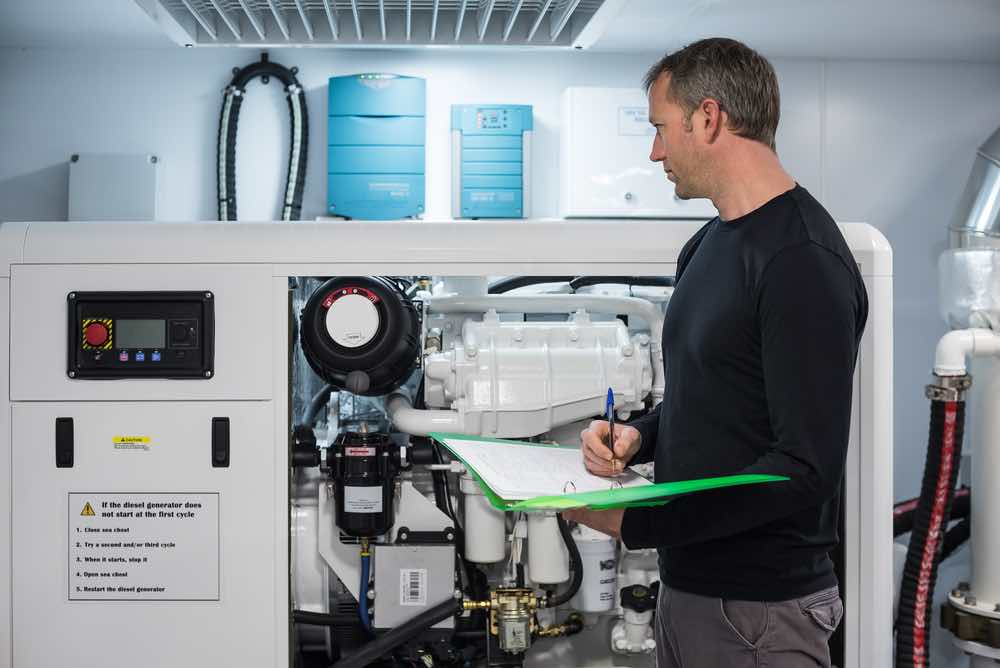
Junior / Assistant Engineer:
- An STCW : EVERY crew member onboard must hold a valid STCW
- An ENG1 Medical Certificate : EVERY crew member onboard must hold a valid ENG1
- AEC 1: The Approved Engine Course 1 is an entry-level qualification for the MCA engineering training schedule and is regarded as the first step on the ladder. It is generally a 5-day / 30-hour course that aims to provide candidates with practical basic hands-on training and theoretical knowledge of diesel engines. The main intention of this course is to teach the knowledge to serve in an ENTRY LEVEL capacity in the engineering department or for a crew member primarily working in another department to assist with engineering functions, for example, a deck/engineer. Holding an AEC certificate will allow you to be a chief engineer on a yacht over 24m and less than 200 Gross Tons or act as an assistant engineer on vessels over 200 GT up to 60NM from a safe haven.
- AEC 2: The Approved Engine Course II follows on from AEC I knowledge. It contains a more practical element when compared to the AEC I. This course has been designed so that engineering qualifications are transferable between different industry sectors such as yachts, workboats, tugs, fishing vessels and so on and there will no longer be offshore limits.
The AEC is your gateway ticket into becoming an engineer, it is, therefore, essential to hold this qualification, gain sea time and work on your training record book (TRB) in order to progress in the engine room.
Becoming a 2 nd Engineer:
There are three routes to obtaining a 2 nd Engineer Officer Small Vessel Certificate of Competency’ (Previously known as Y4):
- Standard Route
- Experienced Seafarer Route
- Alternative Route (For Graduate Engineers)
Standard Route:
This standard route benefits those who study through an accepted route of education involving MSQ (Maritime Studies Qualifications) modules. Completion of these will result in a Diploma in Maritime Studies: Small Vessel Engineer’. This route is extremely beneficial to superyacht engineers because of the reduced sea time required and because some of the syllabi can be completed on-board.
In order to follow this route, you must:
- Hold a Diploma in Maritime Studies: Small Vessel Engineer
- Complete Approved Engine Course I (AEC I) as well as The Approved Engine Course II (AEC II)
- Have completed 12 months’ combined sea service and workshop training, which must include: - 6 months’ seagoing service engaged in watchkeeping or Unmanned Machinery Space (UMS) duties on vessels of at least 350 kW; - 5 months’ seagoing service on vessels of at least 350 kW; - 2 weeks MCA-approved Initial Workshop Skills Training; - A further 2 weeks seagoing service on vessels of at least 350 kW or 2 weeks of MCA-approved additional Workshop Skills Training.
- Complete the MNTB Small Vessel Training Record Book (TRB)
- Complete the Diploma in Maritime Studies: Small Vessel Engineer
- Pass the MCA-approved written exams for - Marine Diesel Engineering ; - Auxiliary Equipment Part – 1 ; - Operational procedures, Basic Hotel Services and Ship construction
- Hold the applicable ancillary and safety courses: - All STCW Basic Training Modules - PSCRB - Advanced Fire Fighting - Proficiency in Medical First Aid - Human Element, Leadership and Management (Operational Level)
- Hold a valid ENG1 Medical Certificate or MCA accepted Equivalent
- Complete MCA oral examination for Second Engineer Officers on Small Vessels less than 9000 kW, less than 3000 GT, unlimited area, III/2 (syllabus available online, go to www.gov.uk and search “Small Vessel Oral Examination Syllabus”).
Experienced Seafarer Route:
This route is for existing seafarers serving on small vessels. You will not be required to complete the Diploma in Maritime Studies: Small Vessel Engineer , however you will need to complete a preparatory college course and SQA written examinations.
To be eligible to register for a study programme you must meet the following requirements:
- Have completed 24 months’ seagoing service on vessels of at least 200 kW
- Hold an Approved Engine Course (Both AEC 1 & AEC 2 )
- Hold STCW Basic Safety Training certificates: - Personal Survival Techniques (STCW Code A-VI/1-1) - Fire Prevention and Fire Fighting (STCW Code A-VI/1-2) - Elementary First Aid (STCW Code A-VI/1-3) - Personal Safety and Social Responsibilities (STCW Code A-VI/1-4)
Requirements / Notice Eligibility to sit MCA Oral Exam:
In addition to the above, candidates must complete the following in order to be issued with a notice of eligibility (noe) to sit an mca oral examination:.
- Additional 11 months’ seagoing on a vessel of 350 kW (must include a minimum of 6 months' seagoing service engaged in watchkeeping or UMS duties)
- 2 weeks MCA-approved initial Workshop Skills Training
- A further 2 weeks seagoing service on vessels of at least 350 kW or 2 weeks of MCA-approved additional Workshop Skills Training.
Certificate of Competency (Coc):
In addition to completing all of the experienced seafarer route requirements above, the candidate must:
- Complete and pass the following courses:
- MCA Marine Diesel Engineering
- MCA Auxiliary Equipment Part - 1
- Operational procedures, Basic Hotel Services and Ship Construction
2. Hold the applicable ancillary and safety course certificates listed in section 5:
- All STCW Basic Training Certificates - PSCRB - Advanced Fire Fighting - Proficiency in Medical First Aid - Human Element, Leadership and Management (HELM Operational Level)
3. Hold a valid ENG1 Medical or ENG1 Medical Equivalent Certificate 4. Pass the MCA oral examination for Second Engineer Officers on Small Vessels less than 9000 kW, less than 3000 GT, unlimited area, III/2 (syllabus available online, go to www.gov.uk and search “Small Vessel Oral Examination Syllabus”)
Alternative Route: (For Graduate Engineers:)
This route is for those candidates who hold a relevant engineering degree/diploma/apprenticeship. These qualifications should be sent to an MCA-approved training provider who will analyze their relevance and explain what the individual should do in order to obtain a 2 nd Engineer Officer Small Vessel CoC.
More information on the types of Graduate and Apprenticeship holders that qualify for this training route can be found in section 3.5 of the MIN 524 Notice .
If you are deemed eligible to enter into this programme you will need to apply directly to an MCA-approved nautical college. In order to find an appropriate college, search www.gov.uk for “MCA-approved nautical colleges".
In order to gain the Certificate of Competency you must:
- Complete a minimum of 6 months’ seagoing service engaged in watchkeeping duties
- Additional seagoing service / Workshop Skill training requirements based on the relevant HND, HNC or Engineering Apprenticeship, as laid out in point 3.5.3 of the MIN 534 Notice.
- Hold an Approved Engine Course I (AEC I)
- Hold an Approved Engine Course II (AEC II)
- Successfully Complete the MCA-approved modules and pass the corresponding exams for:- Marine Diesel Engineering - Auxiliary Equipment Part - 1 - Operational Procedures, Basic Hotel Services & Ship Construction
- Hold the applicable ancillary and safety course certificates:- All STCW Basic Training Certificates - PSCRB - Advanced Fire Fighting - Proficiency in Medical First Aid - Human Element, Leadership and Management (HELM Operational Level)
- Hold a valid ENG1 Medical or ENG1 Medical Equivalent Certificate
- Pass the MCA oral examination for Second Engineer Officers on Small Vessels.
Becoming a Chief Engineer :
- Chief Engineer 3000kw & <500GT
- Chief Engineer 9000kw & <3000GT
Chief Engineer Officer < 3000kW & 500GT
In order to qualify for the issue of this Certificate of Competency you must meet the following requirements:
- Complete a minimum of 6 months’ seagoing service as a Second Engineer on vessels of at least 350 kW (While holding an SV Second Engineer Officer < 9000kW & 3000GT STCW Convention regulation III/2 Certificate of Competency.
- Successfully complete the MCA- approved modules and pass the corresponding written examinations for - Chief Engineer Statutory and Operational Requirements - Auxiliary Equipment part - 2
- Hold the applicable ancillary and safety course certificates: - All STCW Basic Training Certificates - PSCRB - Advanced Fire Fighting - Proficiency in Medical First Aid - Human Element, Leadership and Management (HELM Management Level)
- Pass MCA oral examination for Chief Engineer Officer, less than 3000 kW, less than 500 GT, unlimited area, STCW Reg III/3
Chief Engineer SV <3000 GT & <9,000kW
- 24 months of seagoing service which must include:12 months as an SV Second Engineer or SV Chief Engineer while holding the applicable STCW Convention regulation III/2 Certificate of Competency:
- 6 months of sea service on 350 kW vessels & 6 months seagoing service on vessels 750 kW. (greater or equal to kW provided)
- Chief Engineer (SV) Statutory and Operational Requirements (Not required if SV Chief Engineer less than 3000 kW, less than 500 GT CoC already held)
- Chief Engineer (SV) Auxiliary Equipment Part 2 (Not required if SV Chief Engineer less than 3000 kW, less than 500 GT CoC already held)
- Applied Marine Engineering
- Complete either:a) MCA-approved modules and pass the corresponding written examinations for: General Engineering Science I & General Engineering Science II (exemptions may apply for candidates holding appropriate engineering degree) OR The Diploma in Maritime Studies: Small Vessel and the Diploma in Maritime Studies: Small Vessel Chief Engineer
- All STCW Basic Training Certificates
- Advanced Fire Fighting
- Proficiency in Medical First Aid
- Human Element, Leadership and Management (HELM Management Level)
- Pass the MCA oral examination for Chief Engineer Officer, less than 9,000 kW, less than 3,000 GT, unlimited area, STCW Reg III/3
FOR MORE INFO GO TO MCA WEBSITE MIN524
Alternative Routes to Become a Yacht Engineer:
The above method is the new MCA-approved and advised route to become a YACHT engineer, there are however other options available to you:
Experienced Marine Engineers: Marine engineers with qualifications for larger vessels, such as commercial tankers, container vessels, dredgers etc. or those with merchant navy tickets are usually able to work on yachts with these tickets. It is important to contact the MCA who will review these qualifications and ascertain a plan of action for you.
USCG: It is also possible to qualify as a yacht engineer through the United States Coast Guard route, again different flag states will have different requirements and it is advisable to contact the MCA for any further advice or information.
Find a Training Course Provider
Select a Course in order to view all training providers (use the location filter on the results page in order to refine your search).
STCW Basic Training Advanced Fire Fighting Approved Engine Course (AEC) HELM General Engineering Science 1 General Engineering Science 2 Proficiency in Medical First Aid SV Marine Diesel Engineering Proficiency in Survival Craft & Rescue Boats (PSCRB) SV Auxiliary Equipment SV Operational Procedures SV Applied Marine Engineering
Username or Email Address *
Remember me Lost your password?
Username or Email
Get New Password

Create a free profile to get unlimited access to exclusive videos, sweepstakes, and more!
One Crew Member Was Fired and Another Left During an Explosive Below Deck: "Not Acceptable”
Find out which crew members left St. David on Below Deck Season 11, Episode 7.
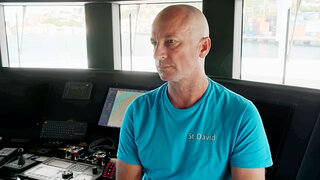
After several weeks of less-than-smooth sailing with the St. David crew, Captain Kerry Titheradge completed his first official Below Deck firing on Season 11, Episode 7 (which aired on March 18).
How to Watch
Watch Below Deck on Bravo Mondays at 9/8c and next day on Peacock . Catch up on the Bravo App .
The Aussie captain, who joined the series for Season 11 after appearing on Below Deck Adventure , let (SPOILER) Jared Woodin go following a series of mistakes as well a conflict with deckhand Kyle Stillie .
Jared wasn't the only yachtie who left the boat, however. Stew Cat Baugh decided to leave the vessel voluntarily after getting a serious phone call from a friend.
More from Bravo:
Below Deck's Jared Woodin Shares Why He Hasn't Met His Daughter Yet
Barbie Pascual Reveals the Surprising Reason She Isn't Divorced and "Legally Married" to Her Ex
See Who Captain Kerry Titheradge Is Confronting in the Middle of the Night: "This Is Unacceptable"
Who did Jared Woodin get fired on Below Deck Season 11, Episode 7?
As soon as Season 11 began, Captain Kerry recognized that Jared wasn't cut out to be the Bosun of a mega yacht. After giving Jared a few charters to see if he could improve during dockings and with his communication, Kerry decided to fire the Connecticut native.
Captain Kerry told Jared, "The way that you're treating these guys is not acceptable, and we've had discussions, and I've tried to guide you, I've shown you compassion. But, you've got sh-t going on, mate. You're your own worst enemy right now. You need to depart the vessel."
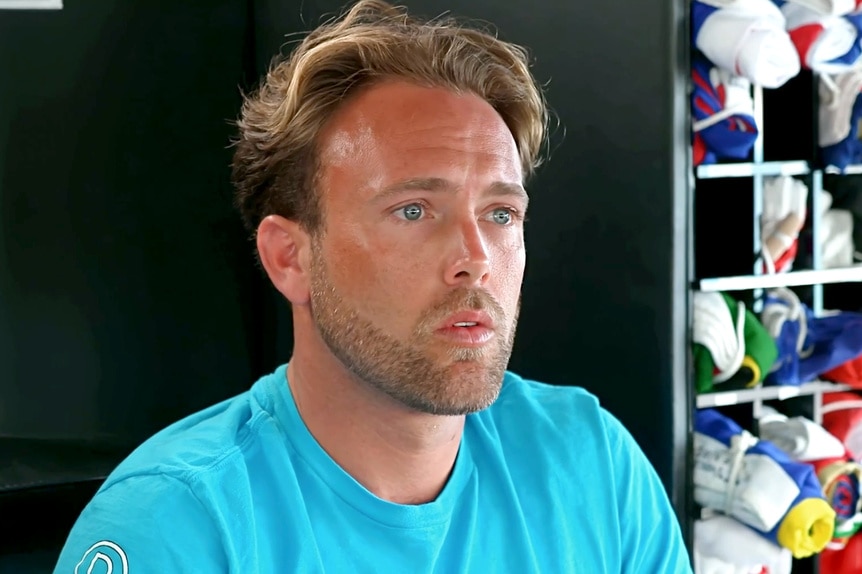
How Jared Woodin Reacted to Getting Fired
Once Kerry fired Jared, the dad of one seemed surprised. "I'm getting the boot?" Jared asked, and Kerry confirmed that was the case. "Really?"
Kerry noted that Jared did "have a lot going for [him]," but that St. David wasn't the right place for him.
"Take this time and work on yourself," Kerry said. "Me keeping you here is a disservice to you."
Jared ultimately agreed with that assessment in an interview on the episode.
"I thought I was in a good headspace coming in to this, [but] I'm really not. And, as much as I would like to be, I'm just lying to myself," he said. "Although the situation sucks, I actually really do feel a little bit lighter."
Watch Captain Kerry Titheradge's Girlfriend Make Her Below Deck Debut
Why did cat baugh leave on below deck season 11.
Jared wasn't the only crew member who left St. David on Season 11, Episode 7. After expressing how it was hard for her to find her place amongst the rest of the yachties, stew Cat Baugh received a troubling phone call from a friend named Megan when she was in her cabin.
"I'm sorry, I know you can't talk, but she's not answering, and no one else is awake right now," Cat's friend said on the phone. "Do you have, like, a couple seconds? I'm freaking the f-ck out."
Cat didn't reveal what exactly the phone call was about, but she recognized that she needed to get back home.
"So, I got a call from my friend, Megan," Cat explained in an interview on the episode. "This is a situation I really can't talk about, but my friends are my family, so it feels really sh-tty not being able to be there for her."
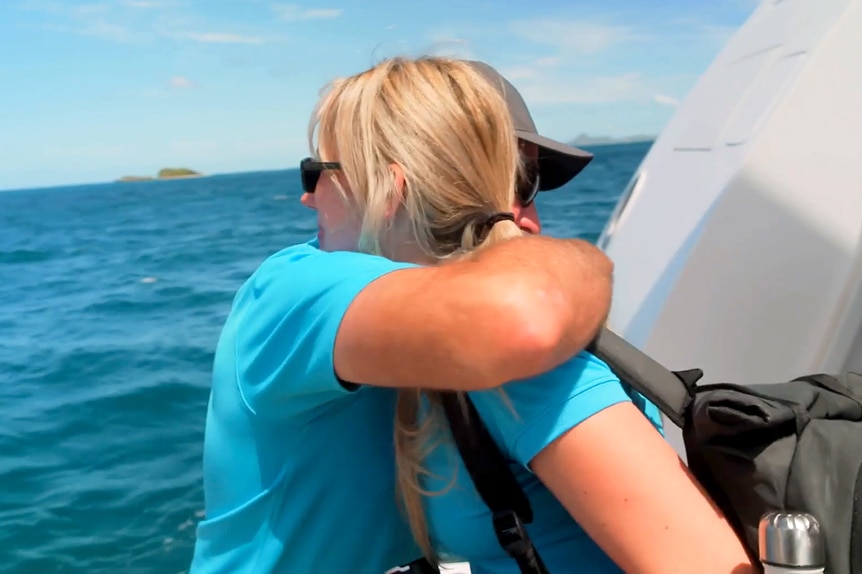
After the charter guests arrived, Cat talked to her boss, Fraser Olender , about what she was feeling. He encouraged her to put her mental health first. Kerry did the same.
"My number one job is to take care of my crew and their health," Kerry said. "I'm well aware of mental health. She's got to go, now."
11 Things You Didn’t Know About Below Deck's Captain Kerry Titheradge
"I wish I could have stayed. But, the thing is, there's no way I could have," Cat concluded. "This is too much. I need to be with the people [who] need me, and also, on this boat, I'm at a breaking point. I need to protect my mental health. It's like my support system is at home, not here."
Watch new episodes of Below Deck on Mondays at 9/8c on Bravo. Stream episodes the next day on Peacock .
- Ben Willoughby
- Jared Woodin
- Kerry Titheradge
Related Stories

See the New Stew on Below Deck Season 11

Get a Glimpse at Below Deck Alum Cat Baugh's Life Today

Why Cat Baugh Left Below Deck Season 11

Ben Opens Up About His Boatmances with Sunny and Camille
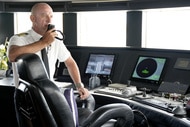
Captain Kerry Just Promoted This Crew Member to Bosun

Who Captain Kerry Is Confronting in the Middle of the Night

Barbie Opens Up About Her Relationship with Her Ex-Husband

Jared Woodin Reveals Why He Hasn't Met His Daughter

Watch Captain Kerry's Girlfriend Make Her Below Deck Debut

Captain Kerry Gushes About His Two Kids
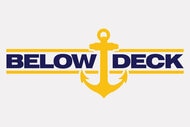
Below Deck Season 11 Trailer Introduces a New Captain: Watch
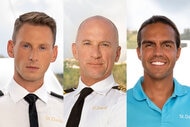
All About Grenada: Details on Below Deck Season 11 Location

Latest Videos
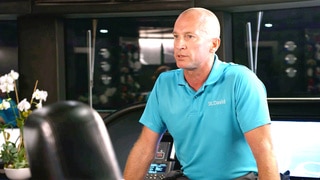
Still to Come on Season 11 of Below Deck

Kerry Titheradge: “Time to Do Some Captain Sh*t”

The Crew Puts on a Murder Mystery Party
Recommended for you.

We Have a Major Update on Tom, Katie, and Katie

Kyle Says She Will Spend Christmas with Mauricio

Kim Richards Just Shocked Kyle with a New Update

IMAGES
COMMENTS
Go to a superyacht marina. 1. Have the right attitude. Along with gaining the correct qualifications to prove your competence, to become a Yachtie, you must have certain characteristics to thrive in this industry. Yachties have to be well presented, articulate, know how to take orders, and be able to work hard, all with a smile and enthusiasm.
Understand the different roles aboard and how you would fit in to them. The term 'yacht crew' refers to at least a dozen-or-so different roles on a superyacht. Some are more hospitality-focused, such as a steward or stewardess, while others are more skill-based, such as an engineer. Whilst you may be planning to enter the industry as a ...
All you need to become Yacht Crew are: A Kickass CV. Your Basic Certifications (above) A Yachting Network . If you plan to look for a job for the Summer Season, you'll need to choose either the USA or the EU. If you're choosing America, make sure you have a B1/B2 visa (mandatory for Yacht crew on that side of the pond) and start your search in ...
When you book our Deckhand and Stewardess packages you also get an included STCW Basic Safety Training week in Croatia or Florida to get your full STCW certification and Basic Safety training. Our packages above include every STCW certificate, Yacht CV and yacht qualifications you need to become a stewardess or deckhand to work as yacht crew on ...
Bosun - Responsible for maintaining the exterior of the yacht and managing crew members. Captain - Sails the yacht. Hires crew members. Requires a captain's license and lots of sailing experience. USEFUL TIP: I always loved working as a deckhand, even though it was kind of the 'man's zone.' The pay is better as a chef on white boats ...
One way to break into crew work is by getting real-world experience in the maritime world, adds Hollingshead. "Go and get a job in a marina, work for a boat-building company, learn about teak, painting, epoxy, etc. 10 Tips for Newbie Deckhands. "There are two main work/life experiences that I value in a candidate," he continues.
1. Get full life-time access to Certificates and YCA Training Online, only pay 50% with the payment plan.. 2. Complete all the training at your own pace from your dashboard with 24/7 access to your personal Instructor and job coach and get your certificates.. 3. We write your CV and start the job search with your personal plan and 10-step checklist.. 4. You get added to our crew community and ...
As you continue to excel in your role and gain the trust of your captain and fellow crew members, you will be well on your way to climbing the yachtie career ladder and achieving your ultimate goal of becoming a captain. 6. Living the Yachtie Lifestyle: Balancing Work and Play on the High Seas.
Dock walking is a good way of getting a job, mainly on small yachts. The usual way to obtain crew work is literally to walk the docks and marinas, visit crew agencies and even frequent pubs/cafés used by existing crew. It is important to dress appropriately, as you are selling yourself. Make sure that you 'look the part' as first impressions ...
You want to work on a superyacht. You have a passion for adventure. You want to earn great money while traveling the world. You are a hard working individual. You're seeking an exciting new career. You want to work for some of the world's most influential people. You want to create a lifestyle - not just a job.
Because of the limited number of crew members, you'll need to be filling multiple roles. When there are guests on board you could be working 14 hour days or longer. A yacht stewardess will be in charge of three main areas: housekeeping, service and laundry. You also need to look after the crew areas and set up and pack down for crew meals.
2.Yacht Steward/Stewardess Training Courses. All superyacht crew need to hold both mandatory and department specific qualifications. All interior crew need to hold an STCW Basic Training Certification, including Proficiency in Security Awareness or Proficiency in Designated Security Duties, a Food and Hygiene Level 2 Certificate as well as other courses depending on your desired role and ...
Course Cost: $1100. Course Duration: 3 Days. Course Location: Orlando. The Rating Forming part of a Navigational Watch certificate is a common requirement for deckhand. The STCW USCG approved course will help you in your path in becoming a more seasoned deckhand. The course provides you with the knowledge and understanding of the duties and ...
But to apply for a job on a yacht the first things you need to have are STCW certificates, ENG 1 and Seaman's book. The good thing is that you can do all those in AYA. Basic safety is a basic STCW certificate that every crew member must have. The course lasts 6 days and after passing the exam you get a certificate recognized from the EU ...
The first edition of her book, "The Insiders' Guide to Becoming a Yacht Stewardess," has been a must-read guide for yacht crew since 2006. With the release of her updated, second edition, Julie hopes to continue to help wannabe "yachties" get into this awe-inspiring industry—if not simply entertain those intrigued by such a career path. ...
For yacht crew. It's free for everyone to browse though all of our current sailing opportunities. Become a member to contact yacht owners and join their crew. Find sailing opportunities. For yacht owners. Registration and posting is free if you are looking for a skipper or crew. Find amateur and professional crew for short or long term voyages.
Step 5 - Daywork and experience. Step 6 - Get the right Yachtie Network and Contacts. Step 7 - Get a Strong Superyacht Reference. Step 8 - Start applying for our Superyacht jobs. Step 9 - Ace your job interviews with your coach. Step 10 - Get a job, bank account and sign contract Claim your Yachtie Careers Deckhand and Stewardess offer.
Julie Perry spent three years as a mega-yacht stewardess, which took her to over 40 ports in 18 countries. And she can tell you how to do it, too. The first edition of her book, "The Insiders' Guide to Becoming a Yacht Stewardess," has been a must-read guide for yacht crew since 2006. With the release of her updated, second edition, Julie ...
Yacht Engine Courses. Yacht Engine Rating (0) Engine-room Watch Rating (2) Approved Engine Course (23) Marine Engine Operator Licence (0) Chief Engineer (Yacht 4) - Less than 200GT and less than 1,500kW (1) Chief Engineer (Yacht 3) - Less than 500GT and less than 3,000kW (0) Chief Engineer (Yacht 2) - Less than 3,000GT and less than 3,000kW (0)
Free Yacht Course - Become Yacht Crew. The first step to your new Career | Create your Members profile in the Introduction course and get started. Enroll for free. What is included ? Everything you need to start your Superyacht Career. Superyacht Introduction Course.
This internationally accredited certificate is a mandatory requirement for all food handlers and servers. It teaches the basic knowledge of how to safely store, handle, cook and serve food onboard a superyacht in a hygienic and safe manner. For chefs working on commercially registered yachts (charter yachts) and/or chefs cooking for 10 or more ...
This route is made up of 6 key certificates: The Approved Engine Course (AEC). Often seen as the base-minimum for superyacht engineers who wish to work on yachts over 24m LOA. Usually a 4-day course covering the theory of compression-ignition (diesel) engines and includes a large amount of practical workshops.
Junior / Assistant Engineer: An STCW: EVERY crew member onboard must hold a valid STCW; An ENG1 Medical Certificate: EVERY crew member onboard must hold a valid ENG1; AEC 1: The Approved Engine Course 1 is an entry-level qualification for the MCA engineering training schedule and is regarded as the first step on the ladder. It is generally a 5-day / 30-hour course that aims to provide ...
Jared wasn't the only crew member who left St. David on Season 11, Episode 7. After expressing how it was hard for her to find her place amongst the rest of the yachties, stew Cat Baugh received a ...